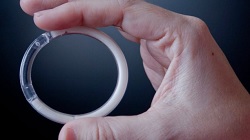 |
| Intravaginal ring designed to release an antiretroviral and a contraceptive--Courtesy of Northwestern U. |
Not long after another study revealed mixed results for an intravaginal ring designed to release two different HIV drugs, researchers in Illinois, Utah and Virginia announced details of their own ring with multiple capabilities, this one with an antiretroviral and a contraceptive. It's the first device capable of protecting women against HIV, herpes and unwanted pregnancy all at the same time, the scientists say.
Northwestern University biomedical engineer Patrick Kiser and collaborators developed the ring, which is designed to be worn for 90 days and which delivers the common antiretroviral drug tenofovir and the contraceptive levonorgestrel. They published details of their device in this month's issue of the journal PLOS ONE.
The ring, called a tenofovir levonorgestrel IVR, is 5.5 centimeters in diameter and designed specifically to deliver the two drugs in different doses and under different conditions. For instance, only 10 micrograms of the contraceptive are needed, whereas 1000 times that amount is needed of the antiretroviral. On top of that, levonorgestrel is highly water-insoluble while tenofovir is highly water-soluble, according to a university report.
To overcome this design challenge, the two delivery sections are made from two kinds of polyurethane, each with a different diffusion rate, with a third polyurethane to keep them separated. The polymer is designed to swell in the presence of fluid, maintaining a consistent release rate over time for each drug.
"I suspect women will use the ring primarily for contraception, but they also will benefit from protection against sexually transmitted diseases," lead author Kiser said in a statement. "And for women in the developing world in particular, unwanted pregnancy can have significant health, economic and cultural consequences. We want to motivate women to use this ring."
- here's the Northwestern University announcement
- and here's the abstract from PLOS ONE